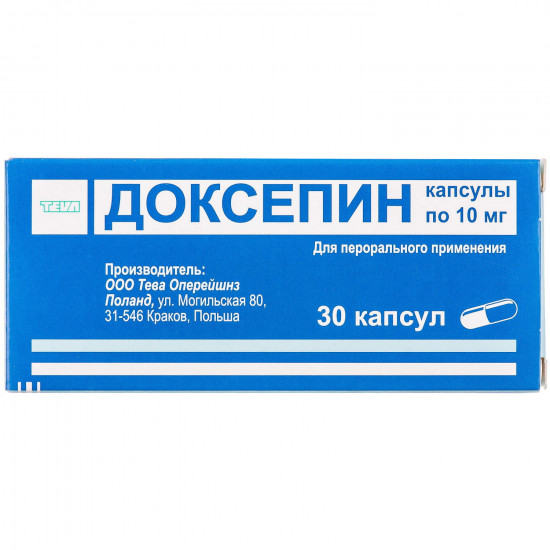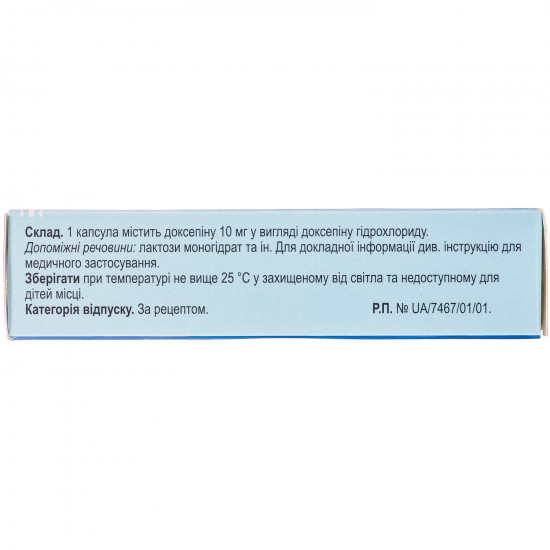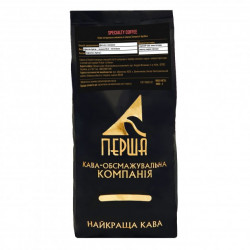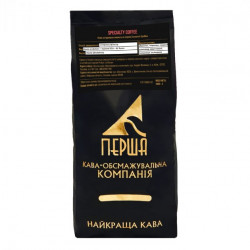



- Stock: In Stock
- Model: 184328
0% Customers recommend this product
-
5 Awesome0%
-
4 Great0%
-
3 Average0%
-
2 Bad0%
-
1 Poor0%
Reviews Over Docsepin kaps. 10 mg No. 30
- (0)
Total Reviews (0)
click here write review to add review for this product.
Report this review.
Description
Pharmacological properties
Pharmacodynamics. docsepin treats to group of tricyclic antidepressants. antidepressive action is combined with anxiolytic and sedative.
Docsepin slows down the return capture of biogenous amines (Norepinephrinum and serotonin) in synoptic structures. Also renders antihistaminic, cholinolytic and α 1 - adrenoceptor blocking action. Does not cause euphoria, psychomotor excitement.
Pharmacokinetics. Docsepin is well soaked up in a GIT, quickly (in 2–4 h after reception) reaches the C max in blood plasma. Steady therapeutic concentration in blood is reached in 2 weeks after an initiation of treatment.
Docsepin is metabolized byin a liver mainly by demethylation with formation of the main metabolite — a desmetildoksepina (nordoksepin). Linking of a docsepin and its metabolites with proteins of blood plasma makes about 76%. Distribution volume — about 20 l/kg of body weight. T ½ docsepina makes 8–24 h, the main active metabolite — 33–80 h Docsepin passes through a placenta and GEB and gets into breast milk.
Indication
Neurotic disorders with symptoms of a depression or alarm. the organic neurosises associated with insomnia. depressive and disturbing states in alcoholism. the depression and disturbing states associated with somatic disorders and diseases.
Depression which is followed by fear and alarm against the background of psychoses including involutional depressions and a depressive phase of bipolar disorders.
Use
is Accepted inside. the dose of medicament is selected individually depending on weight of symptoms and therapeutic effect.
Docsepin's Dose makes 30–300 mg/days. The dose up to 100 mg can be applied as once, and divided. The doses exceeding 100 mg should be applied in 3 receptions. The maximum single dose — 100 mg (to apply before going to bed). At moderate or heavy symptoms the usual initial dose makes 75 mg/days. At most of patients this dose is effective. At severe forms of a disease the dose is raised to 300 mg (in 3 receptions) in day.
At patients with insomnia the general dose should be distributed so that higher dose to apply in the evening. In case about insomnia it is reported as about side reaction, this scheme of reception can also be applied or the dose should be lowered.
After achievement of satisfactory therapeutic effect a dose of medicament should be skorrigirovat to the minimum supporting.
Reduction of expressiveness of symptoms of uneasiness at Docsepin's reception is reached byearlier, than antidepressive effect. Antidepressive action is shown in 2–3 weeks of treatment.
toto Patients of advanced age with moderate symptoms of diseases recommends a half of the usual recommended dose of a docsepin of a hydrochloride (10–50 mg daily). Satisfactory clinical effects were gained after Docsepin's use in a dose of 30-50 mg/days. The dose of medicament should be korrigirovat individually depending on clinical reaction of the patient.
to Patients with abnormal liver functions should reduce doses.
Contraindication
Hypersensitivity to drug, cross sensitivity to other dibenzoksepina. maniacal syndrome; heavy abnormal liver functions; glaucoma; ischuria; simultaneous use with Mao's inhibitors or their use for 2 weeks prior to treatment docsepiny. hypersensitivity to tricyclic antidepressants. tendency to an ischuria.
Side effectsDocsepin is usually had by
well. the majority of moderately severe by-effects arise in an initiation of treatment and disappear after medicament withdrawal or decrease in its dose. some side reactions provided below are not specific to a docsepin, however it is necessary to consider possibility of these reactions thanks to similarity of its pharmacological properties to other tricyclic means. Side reactions are distributed by
on the frequency of manifestations: very often (1/10), it is frequent (1/100, 1/10), infrequently (1/1000, 1/100), is rare (1/10,000, 1/1000), is very rare (1/10,000), it is unknown (frequency cannot be determined according to the available information).
from nervous system and mental disorders: very often — drowsiness; infrequently — a headache, dizziness, insomnia, nightmares, confusion of consciousness, a disorientation, alarm, catalepsy or paresthesias, (usually moderately severe) tremor. At use of medicament in high doses (especially patients of advanced age) can have extrapyramidal symptoms, including late dyskinesia; seldom — hallucinations, an ataxy (in general if use several medicaments operating on central nervous system), convulsions (at the patients inclined to developing of spasms which cause injury of a brain or alcohol intake and toxicomania can be); it is unknown — suicide thoughts and behavior. It was reported about cases of emergence of suicide thoughts and behavior during treatment docsepiny or right after its cancellation.
Mental manifestations, including a mania and paranoid hallucinations, can amplify at treatment by tricyclic antidepressants. It was occasionally reported about a ring in ears.
from an organ of sight: very seldom — a disorder of vision (illegibility).
from the vascular system: seldom — orthostatic hypotension, inflows to the person.
from heart: very seldom — tachycardia, disturbances of the ECG (expansion of the QRS complex, lengthening of an interval of PR).
from the immune system: infrequently — allergic reactions, including rash, a face edema, the increased photosensitivity, an itching, urticaria. During treatment by tricyclic antidepressants aggravation OH is possible.
from skin and hypodermic fabric: seldom — the increased sweating, the above-stated skin allergic reactions; very seldom — an alopecia.
from the system of blood and lymphatic system: seldom — an eosinophilia and dysfunctions of marrow with such symptoms as an agranulocytosis, a leukopenia, thrombocytopenia, a purpura and hemolytic anemia.
from digestive system: very often — xerostomia and a nose, a constipation; seldom — nausea, vomiting, dyspepsia, disturbance of flavoring feelings, diarrhea, anorexia, stomatitis.
from an endocrine system: seldom — disturbance of secretion of antidiuretic hormone, a gynecomastia, increase in mammary glands, a galactorrhoea at women; isolated cases — change of a libido, hypostases of testicles, increase or decrease in level of glucose in blood.
from kidneys and an urinary system: seldom — an ischuria (at men with a prostatauxe of the complaint can amplify).
from a gepatobiliarny system: seldom — jaundice.
General disturbances: very often — fatigue, weakness, increase in body weight, a fever, a hyper pyrexia (at the patients accepting at the same time Chlorpromazinum).
Cancellation of a docsepin. At sudden cancellation of tricyclic antidepressants there can be cancellation symptoms, including insomnia, irritability and excessive sweating. Cancellation symptoms at newborns whose mothers accepted tricyclic antidepressants in the III trimester include oppression of respiratory function, convulsion and hyperreflexia.
Special instructions
to Patients with associated diseases or to the persons accepting other medicines should apply the single mode of dosing. it also concerns the patients using medicaments with anticholinergic action.
to Elderly people also should apply such mode of dosing and with care to korrigirovat it. These patients are inclined to development of such side reactions as alarm, confusion of consciousness and orthostatic hypotension. Therefore it is necessary to appoint an initial dose with care and under careful control of a condition of the patient and his reaction to drug. For the corresponding clinical effect can be rather half dose of a docsepin.
Patients should warn that during treatment there can be a drowsiness and alcohol intake can strengthen effect of drug.
in case of deterioration in symptoms of psychosis or maniacal episodes at treatment docsepiny the dose decline of medicament or addition in the scheme of treatment of medicaments of group of tranquilizers (neuroleptics) can be required.
Though use of a docsepin influences the vascular system, than other tricyclic antidepressants less, it should be applied with care to patients with a serious cardiovascular illness (heart block, cardiac arrhythmia and recently postponed myocardial infarction).
toNeeds care at use of a docsepin for patients with disturbances of kidneys, liver and faces with epileptic seizures in the anamnesis.
Suicide / suicide thoughts or clinical deterioration. Patients with the profound depressions have a risk of emergence of suicide thoughts and actions which can remain up to achievement of remission. In case improvement does not happen within the first several weeks of treatment or even more, careful monitoring is necessary for patients until then when there occurs improvement of a state. From the general clinical practice it is known that the risk of emergence of suicide thoughts or actions can increase at early stages of treatment.
At other psychiatric states for which treatment appoint docsepin also the increased risk of emergence of cases of a suicide exists. Therefore for such patients it is necessary to observe special precautionary measures.
careful monitoring during all treatment of patients with suicide thoughts or attempts to a suicide in the anamnesis Is necessary for.
Careful monitoring of patients, especially groups of high risk, it is necessary to combine with use of the corresponding medicines, especially at early stages with subsequent change of dosing if necessary. It is required to inform patients (and those who conduct their observation) about need of monitoring at emergence of any clinical deterioration, suicide behavior, thoughts or unusual change of behavior and to ask immediately for the help the doctor in case of these symptoms.
Metaanaliz of placebo - controlled researches at use of antidepressants for adult patients with mental disorders showed toincrease in risk of development of suicide behavior at patients aged more young than 25 years in comparison with placebo.
At patients with a prostatauxe of moderate severity the urination delay can amplify.
Docsepin contains lactoses monohydrate therefore to patients with rare hereditary forms of intolerance of a galactose, the sprue of glucose and a galactose, a lactose intolerance of Lapp do not recommend to appoint it.
to Patients with hypersensitivity or intolerance of gluten should not use this medicament as starch is a part of its excipients.
Use during pregnancy or feeding by a breast. The research of reproductive function on animals did not reveal an adverse effect on a fruit; adequate and accurate controlled researches at pregnant women were not conducted. Thus, during pregnancy medicament is used only in cases when the expected advantage for mother exceeds potential risk for a fruit.
Docsepin gets into breast milk therefore during treatment it is necessary to stop feeding by a breast.
Children. Safety and efficiency of use of a docsepin for children are not established.
Ability to influence speed of response at control of vehicles or work with other mechanisms. During treatment docsepiny it is forbidden to run vehicles or to work with the difficult mechanisms demanding concentration of attention as medicament can result in drowsiness and other negative reactions from central nervous system.
Interaction
At simultaneous use of ethanol, antidepressants, barbiturates, benzodiazepines and general anesthetics perhaps considerable strengthening of the oppressing action on central nervous system, respiratory depression and hypotensive effect. docsepin increases anticholinergic action of an amantadin. fenotiazina, protivoparkinsonichesky medicines, atropine, Biperidinum, antihistamines increase risk of emergence of side effects from central nervous system, sight, intestines, a bladder. at simultaneous use with antihistamines, a clonidine the oppressing action on central nervous system amplifies, with atropine — the risk of emergence of paralytic intestinal impassability, with the medicines causing extrapyramidal reactions increases — the body weight and frequency of extrapyramidal effects increases. at simultaneous use of a docsepin with indirect anticoagulants (derivatives of coumarin or an indadion) the increase in anticoagulating activity of the last is possible. docsepin can strengthen the depression caused gks. at the combined use with anticonvulsants strengthening of the oppressing action on central nervous system, reduction of the threshold of convulsive readiness (is possible at use in high doses) and decrease in efficiency of the last. medicaments for treatment in a thyrotoxicosis increase risk of developing an agranulocytosis. docsepin reduces efficiency of Phenytoinum and α-adrenoblockers. inhibitors of microsomal oxidation (Cimetidinum) extend t½, increase risk of development of toxic effects of a docsepin (the dose decline of a docsepin for 20–30% can be required), inductors of microsomal enzymes of a liver (barbiturates, carbamazepine, Phenytoinum, nicotine and oral contraceptives) reduce concentration in blood plasma and efficiency of a docsepin. fluoxetine and fluvoksamin increase concentration of a docsepin in blood plasma (the dose decline of a docsepin for 50% can be required). at simultaneous use with holinoblokator, fenotiazina and benzodiazepines — mutual strengthening sedative and central holinoblokiruyushchy effects and increase in risk of developing of epileptic seizures (reduction of the threshold of convulsive readiness); fenotiazina, besides, can increase risk of emergence of an antipsychotic malignant syndrome. at simultaneous use of a docsepin with a clonidine, guanetidiny, betanidiny, reserpine and metildopy — decrease in hypotensive effect of the last; with cocaine — risk of developing arrhythmia of heart. estrogensoderzhashchy oral contraceptives and estrogen can increase bioavailability of a docsepin; antiarrhytmic means (quinidine) increase risk of development of disturbances of a rhythm (possibly delay of metabolism of a docsepin). simultaneous use with Disulfiramum and inhibitors of an atsetaldegidrogenaza provoke a delirium. it is incompatible with Mao's inhibitors (possibly increase in frequency of the periods of a hyper pyrexia, heavy spasms, hypertensive crisis and the death of the patient). Pimozidum and probucol can strengthen heart arrhythmia that is shown by lengthening of an interval of q-t on the ECG. action on the cardiovascular system of epinephrine, Norepinephrinum, an izoprenalin, ephedrine and Phenylephrinum amplifies (including when these means are a part of local anesthetics) and risk of development of disturbances of a warm rhythm, tachycardia, heavy ag increases. simultaneous use of blockers of α-adrenoceptors for intranasal introduction or for use in ophthalmology (at considerable system absorption) can strengthen vasoconstrictive action of the last. at the combined use with hormones of a thyroid gland — mutual strengthening of therapeutic effect and toxic action (including arrhythmia of heart and promoting effect on central nervous system). the m-holinoblokatory and neuroleptics increase risk of development of a hyper pyrexia (especially at hot weather).
Overdose
Symptoms: drowsiness, concern, dryness in a mouth, a stupor, a disorder of vision, arrhythmia. at emergence of similar symptoms medicament it is necessary to cancel and examine the patient.
At heavy overdose the decrease/increase in the ABP, expansion of pupils, tachycardia, an ischuria (bladder atony), Ilheus, a hyperthermia/hypothermia, respiratory depression, the strengthened sweating, spasms, a coma are possible.
Treatment: termination of administration of drug, gastric lavage, artificial ventilation of the lungs, control of a cardiovascular system, use of sleeping medicines. In case of need — administration of physostigmine of salicylate of 1-3 mg. Symptomatic therapy. The hemodialysis and an artificial diuresis are inefficient.
Storage conditions
At a temperature not above 25 °C in the place protected from light.
Specifications
| Characteristics | |
| Active ingredients | Docsepin |
| Amount of active ingredient | 10 mg |
| Applicant | Teva |
| Code of automatic telephone exchange | N06AA12 Docsepin |
| Interaction with food | It doesn't matter |
| Light sensitivity | Sensitive |
| Market status | Generic-generic |
| Origin | Chemical |
| Prescription status | According to the prescription |
| Primary packing | blister |
| Producer | TEVA OPEREYSHNZ POLAND OF LTD COMPANY |
| Quantity in packing | 30 capsules (3 blisters on 10 pieces) |
| Release form | capsules for internal use |
| Route of administration | Oral |
| Sign | Import |
| Storage temperature | from 5 °C to 25 °C |
| Trade name | Docsepin |




















